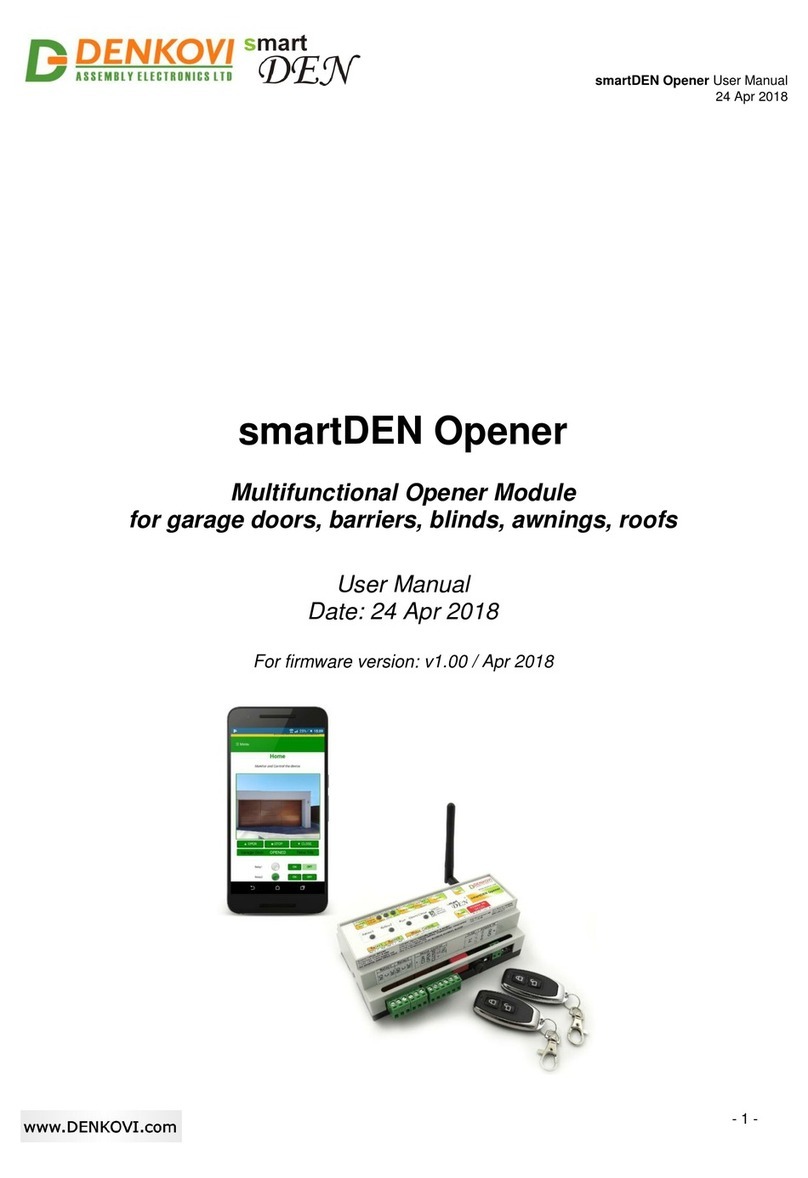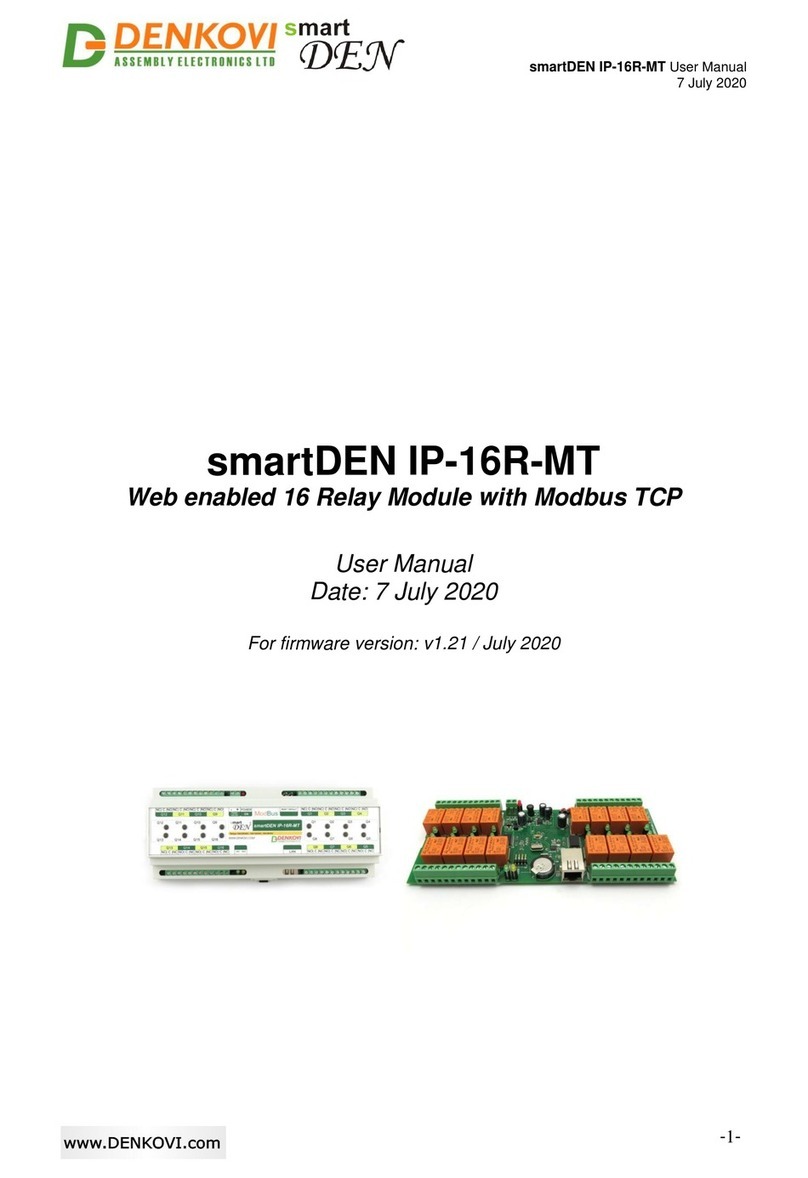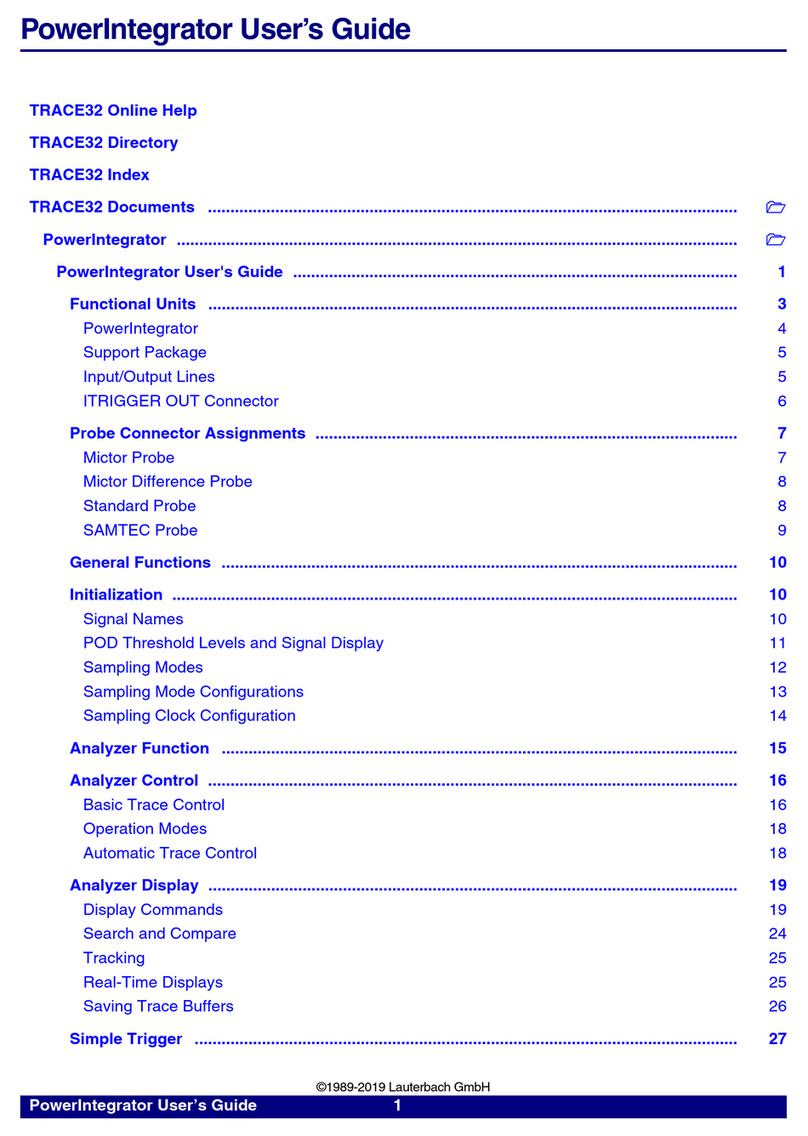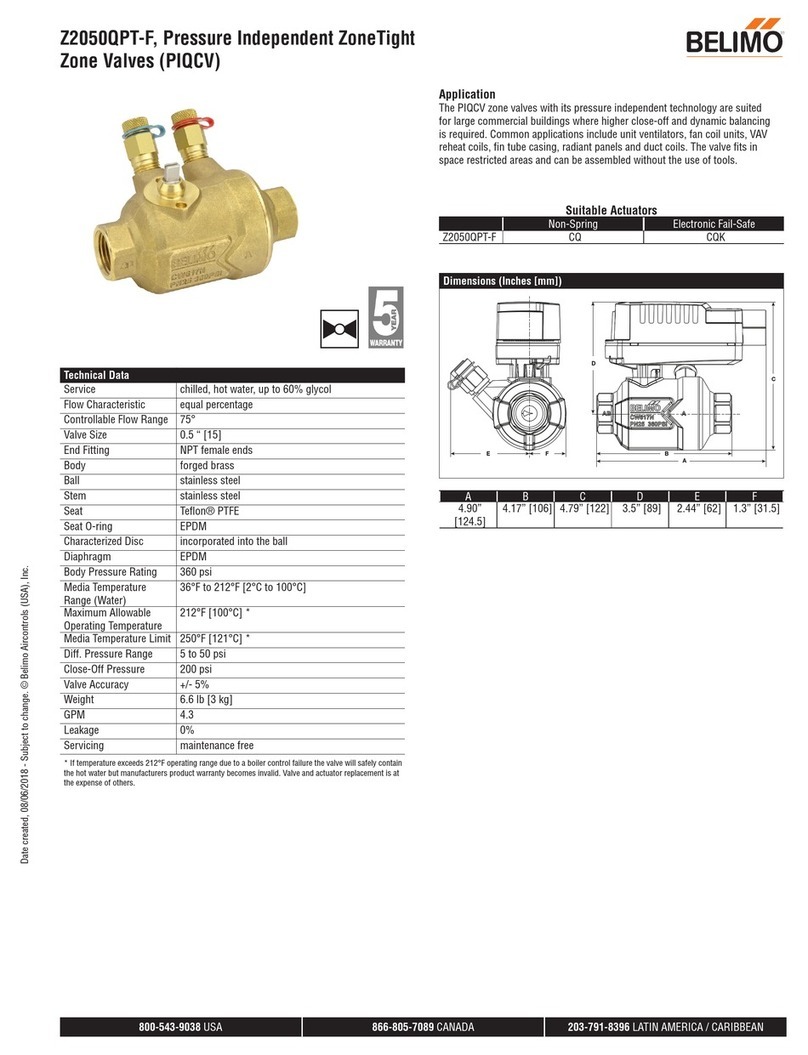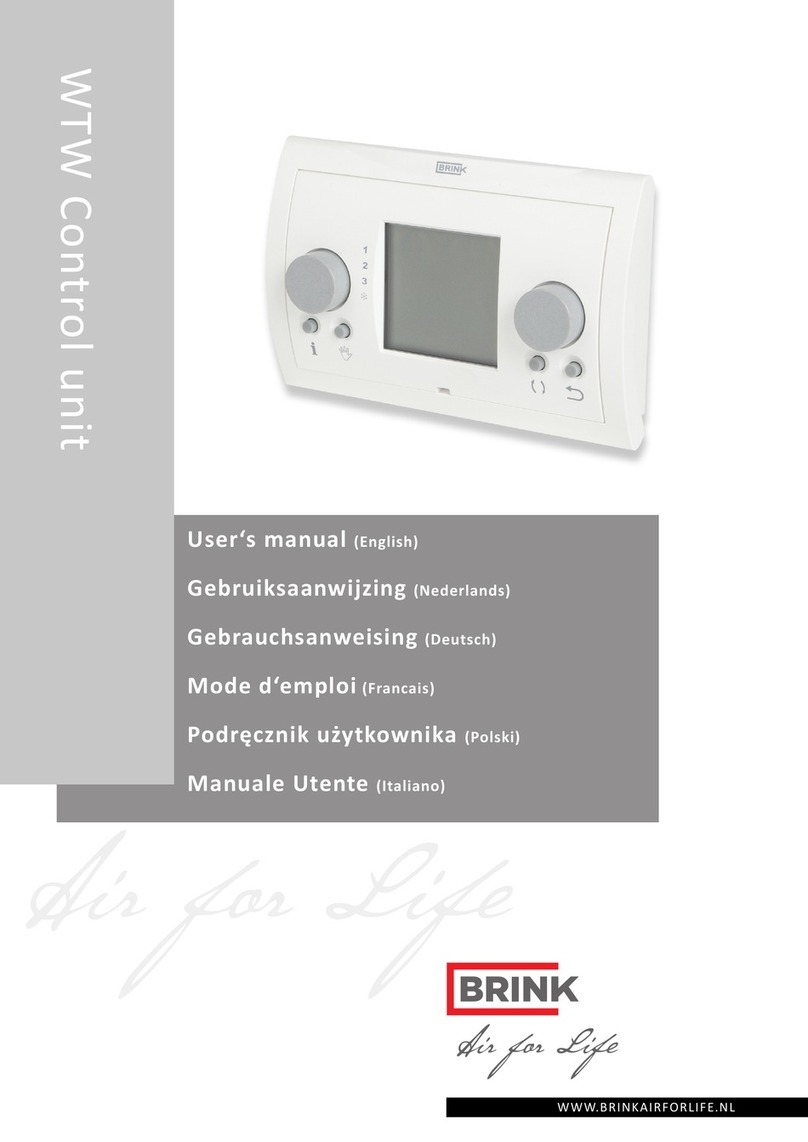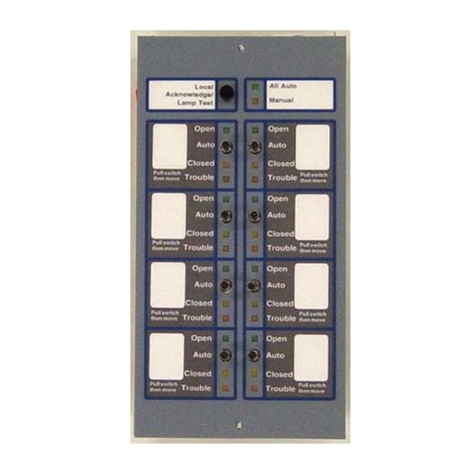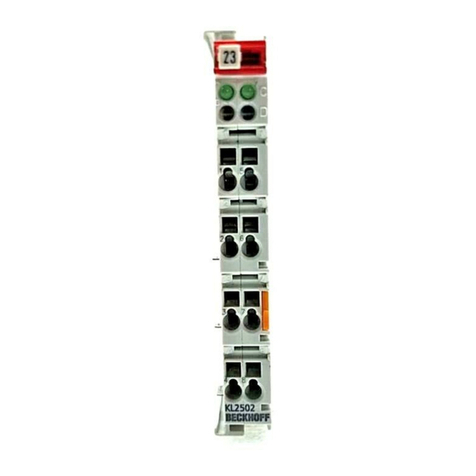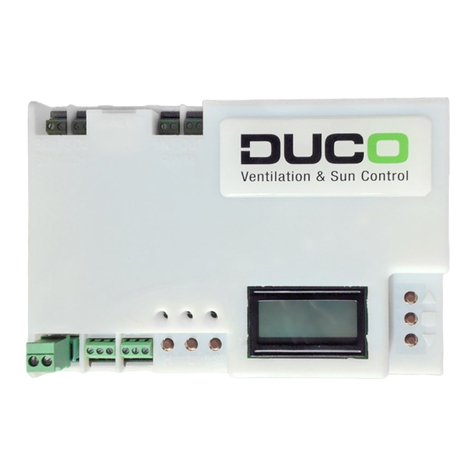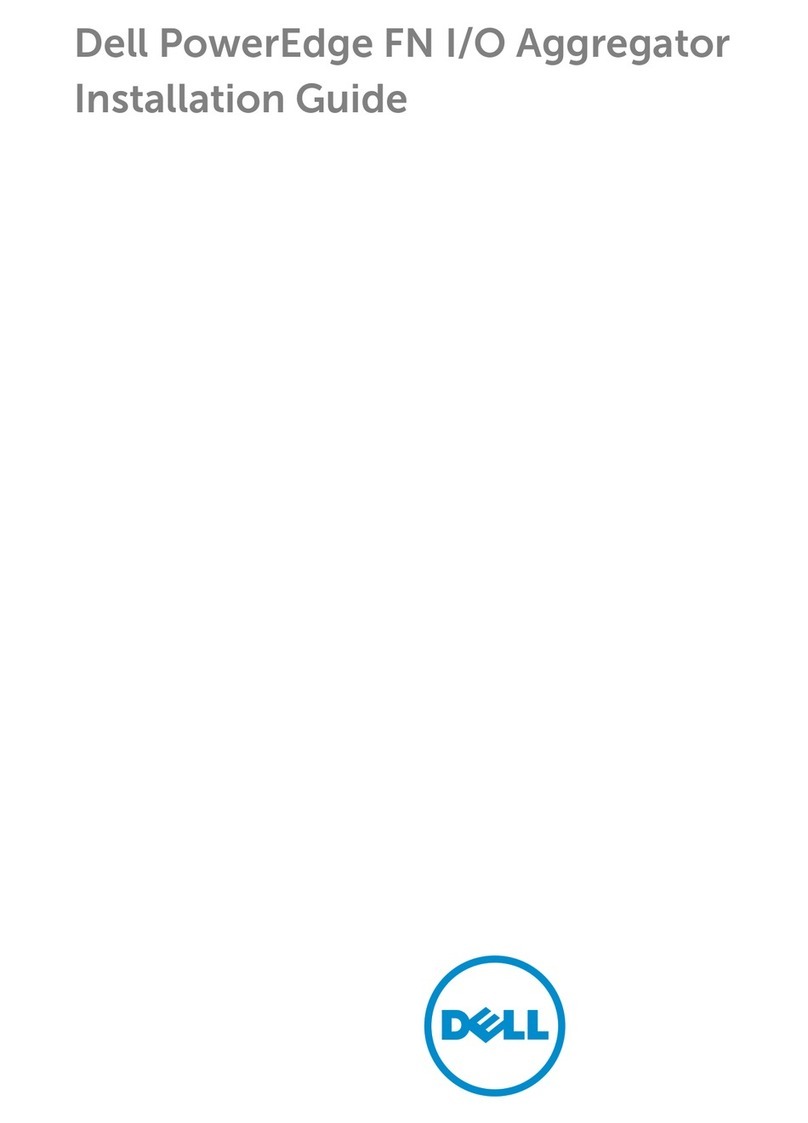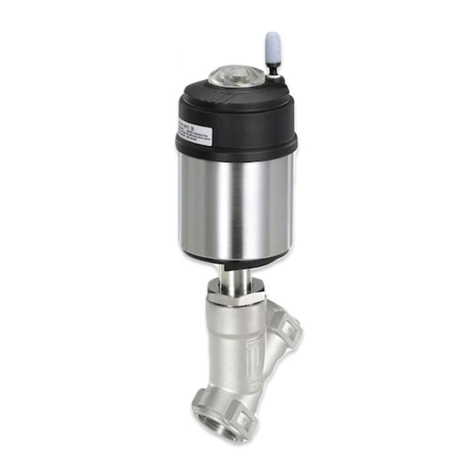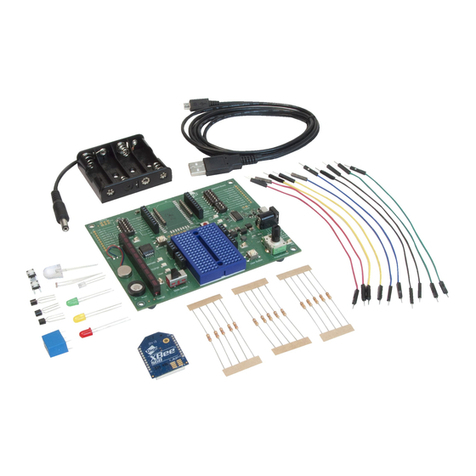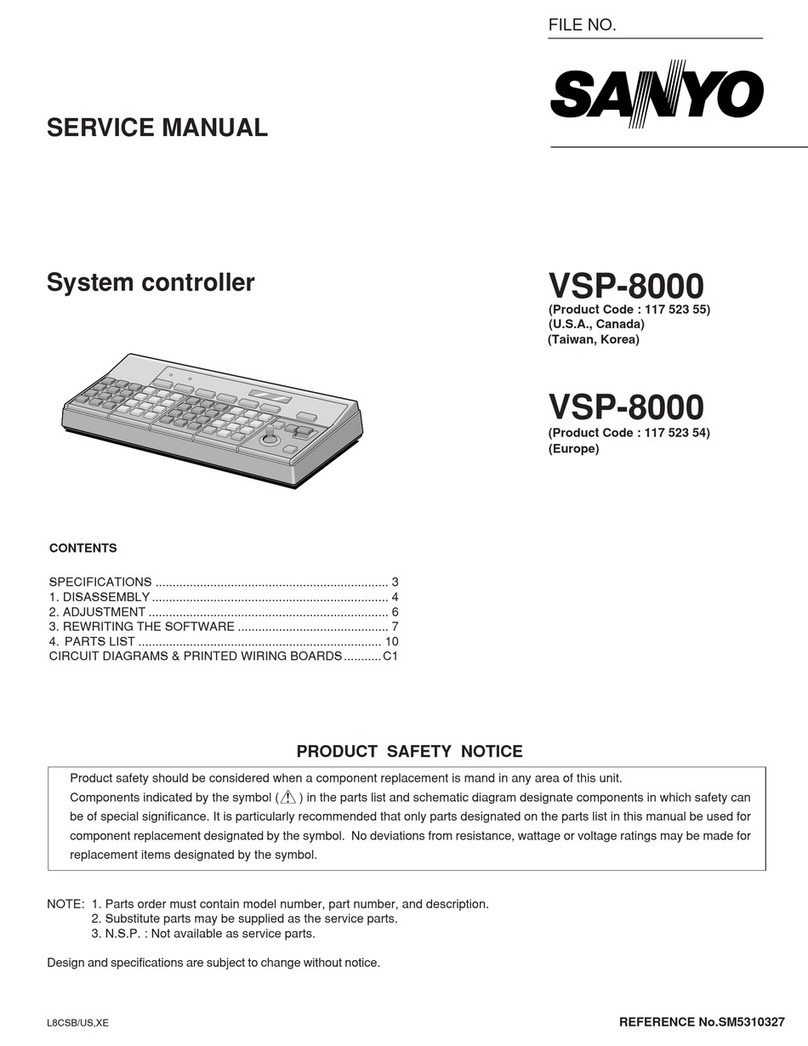Denkovi DAEnetIP4 User manual

Page 1
DAEnetIP4 SNMP 12 Channel I/O
Relay Module
User's Manual
Date: 19 June 2018

Page 2
Content
1. About this document........................................................................................... 3
2. Overview............................................................................................................ 4
3. Relay Outputs .................................................................................................... 5
4. Digital Inputs (counters) ..................................................................................... 8
5. Analog Inputs................................................................................................... 11
6. PWM Outputs................................................................................................... 14
7. Installation........................................................................................................ 15
8. Loading the default (factory) settings ............................................................... 21
9. Restart the module........................................................................................... 22
10. PCB dimensions .......................................................................................... 23

Page 3
1. About this document
This document describes only the specific features of the device DAEnetIP4
Internet/Ethernet 12 Channel Relay Board - I/O, SNMP, Web. This module consist of
DAEnetIP4 controller and extension I/O relay board which is the main object of this
document. For full description of the all DAEnetIP4 features, you can refer to
DAEnetIP4 user's manual.

Page 4
2. Overview
Figure 1. Module overview
Features:
12 x SPDT relays (NO,C,NC) - 10A / 250VAC, 15A / 120VAC, 10A /
28VDC;
8 x digital inputs port with schmitt trigger (0-12VDC or 0-24VDC). The
inputs are combined with 16 bit cyclic counters as well;
8 x analog inputs (0-10VDC)
2 x PWM outputs (coming from DAEnetIP4)
Led indicators for: relays, digital inputs, power on
Sensor supply output
Some of the above parameters can be changed by request
MPN reference (ordering codes):
DAE-PB-RO12-12V/DI8/AI8+DAEnetIP4 (for 12V version)
DAE-PB-RO12-24V/DI8/AI8+DAEnetIP4 (for 24V version)

Page 5
3. Relay Outputs
The module provides 12 SPTD relays (NO, C, NC) and for every relay there is led
indicator showing the relay state. When the led is ON, that means the relay is
activated and when OFF, the relay is not activated.
Figure 2. Location of the relays
Table 1. Relays electrical characteristics
Relay outputs count
12
Contact type
NO, NC
Current consumption
mA
15
Switching parameters
A
A
A
A
10 (28 VDC)
15 (120 VAC)
10 (250 VAC)
Table 2. Mapping to DAEnetIP4 JP1/JP3 digital output port
Digital output pin # (DAEnetIP4 JP1 and
JP3)
Relay # (from peripheral board)
Digital Output #1 (JP1.1)
Relay 1
Digital Output #2 (JP1.2)
Relay 2
Digital Output #3 (JP1.3)
Relay 3
Digital Output #4 (JP1.4)
Relay 4
Digital Output #5 (JP1.5)
Relay 5
Digital Output #6 (JP1.6)
Relay 6
Digital Output #7 (JP1.7)
Relay 7
Digital Output #8 (JP1.8)
Relay 8
Digital Output #9 (JP3.1)
Relay 9
Digital Output #10 (JP3.2)
Relay 10
Digital Output #11 (JP3.3)
Relay 11
Digital Output #12 (JP3.4)
Relay 12

Page 6
3.1. How to control the relays
3.1.1. Web browser
The relays states can be changed from the "Monitoring and Control" web page up
on changing the dropdown combo-boxes (On/Off) in the section "Digital Outputs":
Figure 3. Monitoring and Control web page - digital outputs control
3.1.2. Example SNMP commands
oSNMP GET COMMANDS
Get Relay 1 State
snmpget -v1 -c read 192.168.1.100 .1.3.6.1.4.1.42505.1.2.3.1.11.0
DENKOVI-MIB::DigitalOutputState.0 = INTEGER: off(0)
Get Relay 12 State
snmpget -v1 -c read 192.168.1.100 .1.3.6.1.4.1.42505.1.2.3.1.11.11
DENKOVI-MIB::DigitalOutputState.11 = INTEGER: on(1)
Get all relays states with single command
snmpget -v1 -c read 192.168.1.100 .1.3.6.1.4.1.42505.1.3.2.0
DENKOVI-MIB::DigitalOutputsState.0 = INTEGER: 65535

Page 7
oSNMP SET COMMANDS
Set Relay 1 State OFF
snmpget -v1 -c read 192.168.1.100 .1.3.6.1.4.1.42505.1.2.3.1.11.0 i 0
DENKOVI-MIB::DigitalOutputState.0 = INTEGER: off(0)
Set Relay 12 State
snmpget -v1 -c read 192.168.1.100 .1.3.6.1.4.1.42505.1.2.3.1.11.11 i 1
DENKOVI-MIB::DigitalOutputState.11 = INTEGER: on(1)
Set all relays states with single command
snmpget -v1 -c read 192.168.1.100 .1.3.6.1.4.1.42505.1.3.2.0 i 65535
DENKOVI-MIB::DigitalOutputsState.0 = INTEGER: 65535
3.2. How to use the relays
3.2.1. Controlling lamp
Figure 4. Controlling lamp
3.2.2. Controlling inductive load
You can read our article how to handle inductive loads for more information:
http://denkovi.com/controlling-inductive-devices

Page 8
4. Digital Inputs (counters)
Figure 5. Location of the digital inputs
DAEnetIP4 IP controller (the core of the current module) supports 8 digital inputs
every of which is combined with 16 bit cyclic counter. These inputs are extended with
Schmitt triggers in this module so they are able to handle voltages from 0 up-to 30V
DC. Moreover every digital input can control digital output (relay) and send traps up-
on falling and/or rising edge of the input signal. For more information please refer to
the DAEnetIP4's documentation here:
http://denkovi.com/Documents/DAEnetIP4/Current-Version/UserManual.pdf
Table 3. Digital inputs electrical characteristics
Type
Peripheral board
Digital inputs count
8
Nominal value of inputs
Voltage
Current
VDC
mA
12
5.2
Max non desctructive voltage
VDC
30.0
Input switching limit values
From 0 to 1 Voltage
Current
From 1 to 0 Voltage
Current
VDC
mA
VDC
mA
>7.6
>3.2
<4.5
<1.8
Input impedance at state 1
kΩ
2.2
Sensor compability
2-wire
3-wire
Yes PNP
No
Input type
Resistive with Schmitt
trigger
Isolation
Between supply and
inputs
Between inputs
No
No
Protection
Against reverse polarity
Yes
Table 4. Mapping to DAEnetIP4 JP2 digital inputs (counters) port
Digital input pin # (DAEnetIP4 JP2)
Digital Input # (peripheral board)
Digital Input #1 (JP2.1)
Din1
Digital Input #2 (JP2.2)
Din2
Digital Input #3 (JP2.3)
Din3
Digital Input #4 (JP2.4)
Din4
Digital Input #5 (JP2.5)
Din5
Digital Input #6 (JP2.6)
Din6
Digital Input #7 (JP2.7)
Din7

Page 9
Digital Input #8 (JP2.8)
Din8
4.1. How to read the digital inputs (counters)
4.1.1. Web browser
The inputs states and counter values can be monitored from the "Monitoring and
Control" web page and they are located in the section "Digital Inputs".
Figure 6. Monitoring and Control web page - digital inputs/counters monitoring
4.1.2. Example SNMP commands
Get Din1 Value
snmpget -v1 -c read 192.168.1.100 .1.3.6.1.4.1.42505.1.2.1.1.7.0
DENKOVI-MIB::DigitalInputState.0 = INTEGER: off(0)
Get Counter1 Value
snmpget -v1 -c read 192.168.1.100 .1.3.6.1.4.1.42505.1.2.1.1.7.0
DENKOVI-MIB:: DigitalInputCounter.0 = INTEGER: 12345
Get Din8 Value
snmpget -v1 -c read 192.168.1.100 .1.3.6.1.4.1.42505.1.2.1.1.3.0
DENKOVI-MIB::DigitalInputState.0 = INTEGER: on(1)
Get Counter8 Value
snmpget -v1 -c read 192.168.1.100 .1.3.6.1.4.1.42505.1.2.1.1.7.7
DENKOVI-MIB:: DigitalInputCounter.7 = INTEGER: 12345
Get all digital inputs values with single command
snmpget -v1 -c read 192.168.1.100 .1.3.6.1.4.1.42505.1.3.1.7
DENKOVI-MIB::DigitalInputsState.0 = INTEGER: 255

Page 10
4.2. How to use the digital inputs
Figure 7. How to use digital inputs

Page 11
5. Analog Inputs
The analog inputs are extended to 0-10V DC. Currently there is 270K resistor
connected in sequence of the ADC, so the resistor divisor is calibrated to work in the
0-10V DC range.
The input voltage range of 0-10V DC can be changed up-on request.
The resistors used for building the module are +-5%. The ADC of the
DAEnetIP4 also have some tolerance, so additional software calibration
may be necessary.
Figure 8. Location of the analog inputs port
Figure 9. Analog inputs extension schematic

Page 12
Table 5. Analog inputs electrical characteristics
Type
Peripheral board
Analog inputs count
8
Input range
VDC
0...10
Input impedance
KΩ
270
Max non desctructive voltage
V
24
Value of LSB
mV
10
Input type
Common mode
Conversion
Resolution
Precision
Repeat accuracy
V
V
mA
10 bits at maximum voltage
determinated by parameter
determinated by parameter
Isolation
Beteen analog
channel and
supply
No
Protection
Against reverse
polarity
Yes
Table 6. Mapping to DAEnetIP4 JP4 analog input port
Analog input pin # (DAEnetIP4 JP4)
Analog Input # (peripheral board)
Analog Input #1 (JP4.1)
Ain1
Analog Input #1 (JP4.2)
Ain2
Analog Input #1 (JP4.3)
Ain3
Analog Input #1 (JP4.4)
Ain4
Analog Input #1 (JP4.5)
Ain5
Analog Input #1 (JP4.6)
Ain6
Analog Input #1 (JP4.7)
Ain7
Analog Input #1 (JP4.8)
Ain8

Page 13
5.1. How to read the analog inputs
The analog inputs values can be monitored from the "Monitoring and Control" web
page and they are located in the section "Analog Inputs".
5.1.1. Web browser
Figure 10. Monitoring and Control web page - Analog Inputs monitoring
5.1.2. Example SNMP commands
Get Ain1 Level
snmpget -v1 -c read 192.168.1.100 .1.3.6.1.4.1.42505.1.2.2.1.6.0
DENKOVI-MIB::AnalogInputValue.0 = INTEGER: 107
Get Ain8 Level
snmpget -v1 -c read 192.168.1.100 .1.3.6.1.4.1.42505.1.2.2.1.6.7
DENKOVI-MIB::AnalogInputValue.7 = INTEGER: 555

Page 15
7. Installation
7.1. Connect
This device must be installed by qualified personnel;
This device must not be installed directly outdoors;
Installation consists of mounting the device, connecting to an IP network,
connecting the I/O, providing power and configuring via a web browser.
7.2. Power supply requirements
Figure 12. Location of DAEnetIP4 12 Relay Module power jack
The whole module has the following current consumption:
400mA at 24V DC (and all relays are ON)
700mA at 12V DC (and all relays are ON)
It is recommended the supply source for DAEnetIP4 12 Relay Module to be with
the following parameters:
Supply voltage: 7.5V - 25V DC;
Current: minimum 700mA;
It must be stabilized and filtered;
Type: center positive (the inner pin of the power supply adaptor jack must be
+VCC).

Page 16
+VCC
GND
(NEGATIVE)
Figure 13. How the power supply cable must looks like
Additionally, you can check if the supply adaptor has this sign:
+-
Figure 14. The power supply must be marked with this sign
DAEnetIP4 12 Relay Module has protection against reverse polarity
which is actually diode in parallel of the supply jack but it is still not
recommended to reverse the voltage polarity!
DAEnetIP4 12 Relay Module does not accept AC supply voltage. It is
highly recommended to check the power supply source parameters before
turning on the module.
The power supply equipment shall be resistant to short circuit and
overload in secondary circuit.
When in use, do not place the equipment so that it is difficult to disconnect
the device from the power supply.
7.3. Network connection
DAEnetIP4 12 Relay Module supports AUTO-MDIX so either "crossover" or
"straight-through" network cable can be used.

Page 17
Figure 15. UTP Cable
Figure 16. Connecting DAEnetIP4 12 Relay Module to a computer directly
(recommended initial connection)
Figure 17. Connecting DAEnetIP4 12 Relay Module to a wireless router.
7.4. Communication setup
DAEnetIP4 is shipped with the following default parameters:
IP address: 192.168.1.100
Subnet mask: 255.255.255.0
Gateway: 192.168.1.1
Web password: admin

Page 18
Initially it is recommended to connect the module directly to the computer.
Next you have to change your PC’s IP address.
You can Google how to change you computer IP settings or just visit this
web page: http://www.howtochangeipaddress.com/changeip.php
For Windows 7 OS for example you can do that in the following way:
Navigate to Control Panel -> Network and Internet -> View network and status
tasks -> Change adapter settings
Then just select the local area connection with right click and select Properties:
Figure 18. LAN card properties

Page 19
The next step is to enter into IPv4 properties.
Figure 19. Enter in IPv4 properties section
Set the IP address of your PC to be in the same network.
Figure 20. Set the IP address

Page 20
Finally, in order to access DAEnetIP4 12 Relay Module just type in your browser
192.168.1.100
Figure 21. Open the device via browser
If the network settings are O’K, the log-in page should appear:
Figure 22. Login page
DAEnetIP4 modules connected locally can be easily scanned and found
via the tool Denkovi Finder as well.
Figure 23. Denkovi Finder
Other manuals for DAEnetIP4
2
This manual suits for next models
1
Table of contents
Other Denkovi Control Unit manuals
Popular Control Unit manuals by other brands

Quectel
Quectel SG865W Series Hardware design
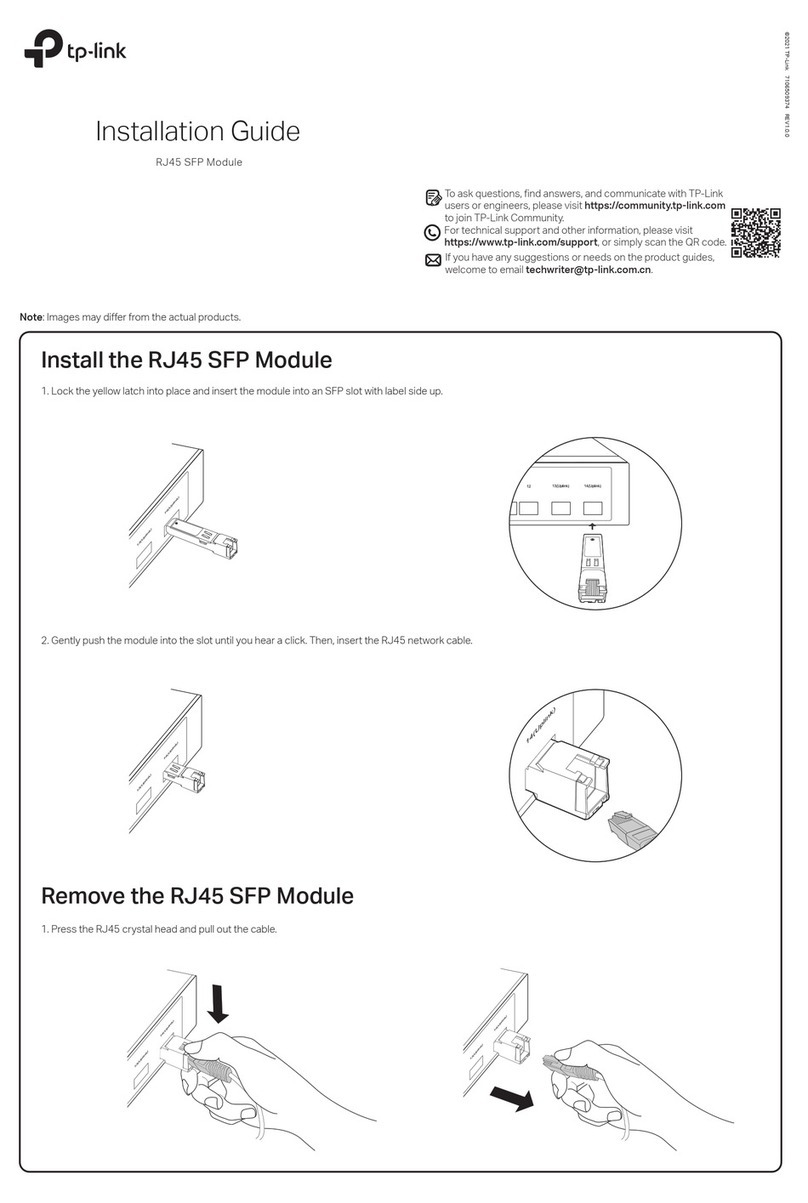
TP-Link
TP-Link TL-SM331T installation guide
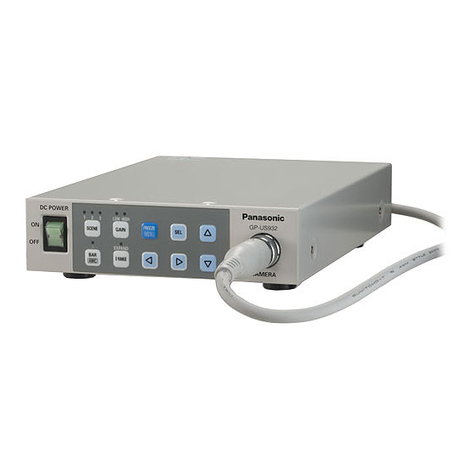
Panasonic
Panasonic GP-US932CSAE operating instructions
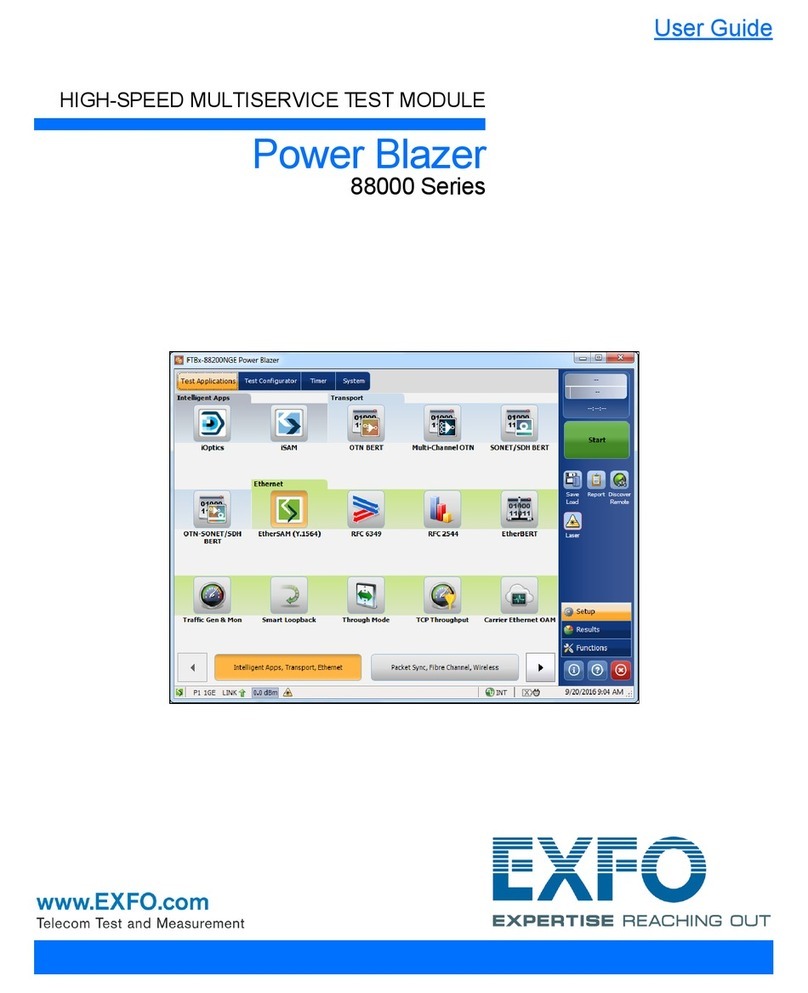
EXFO
EXFO Power Blazer 88000 Series user guide

jbc
jbc DDU instruction manual
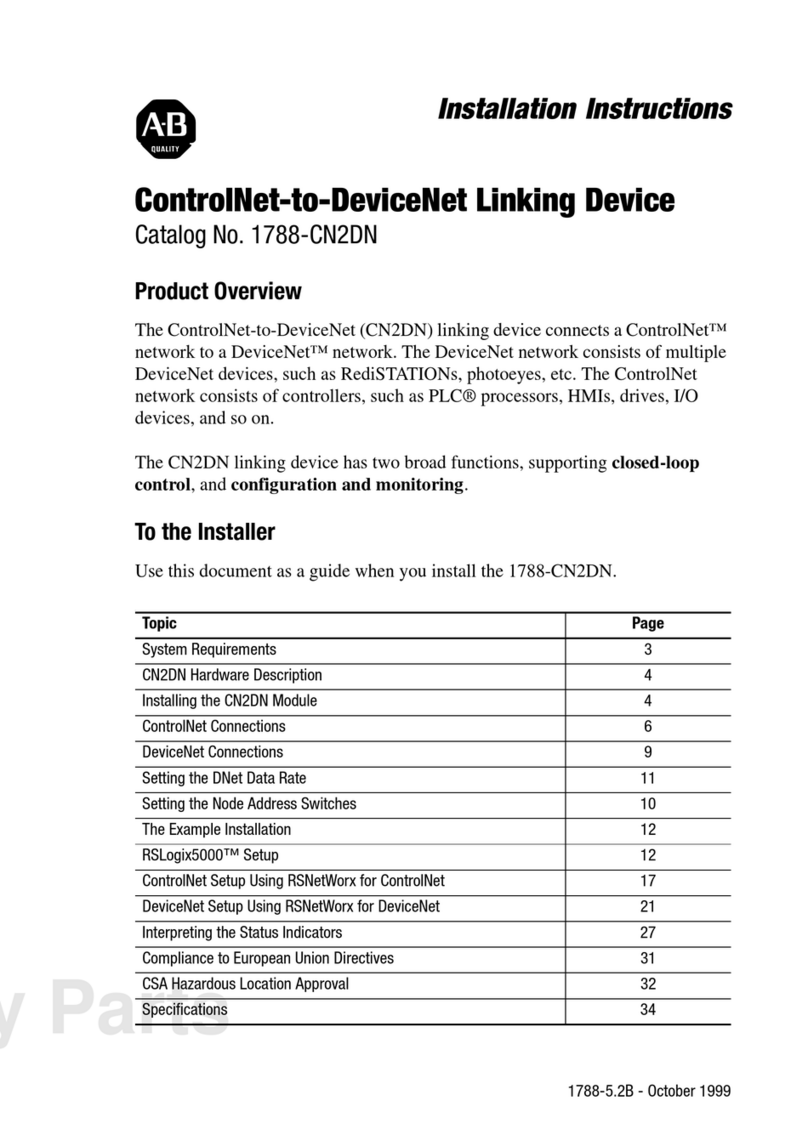
Allen-Bradley
Allen-Bradley ControlNet-to-DeviceNet 1788-CN2DN installation instructions

